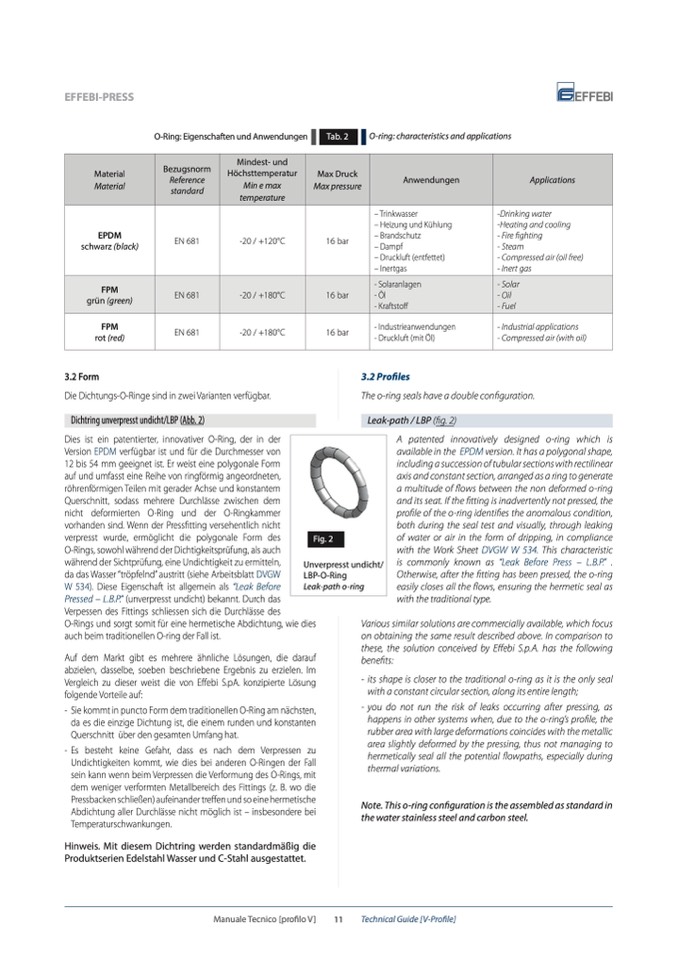
EFFEBI-PRESS
O-Ring: Eigenschaften und Anwendungen
Tab. 2
O-ring: characteristics and applications
Material
Material
Bezugsnorm
Reference
standard
Mindest- und
Höchsttemperatur
Min e max
temperature
Max Druck
Max pressure
Anwendungen
Applications
EPDM
schwarz (black)
EN 681
-20 / +120°C
16 bar
– Trinkwasser
– Heizung und Kühlung
– Brandschutz
– Dampf
– Druckluft (entfettet)
– Inertgas
-Drinking water
-Heating and cooling
- Fire fighting
- Steam
- Compressed air (oil free)
- Inert gas
FPM
grün (green)
EN 681
-20 / +180°C
16 bar
- Solaranlagen
- Öl
- Kraftstoff
- Solar
- Oil
- Fuel
FPM
rot (red)
EN 681
-20 / +180°C
16 bar
- Industrieanwendungen
- Druckluft (mit Öl)
- Industrial applications
- Compressed air (with oil)
3.2 Form
3.2 Profiles
The o-ring seals have a double configuration.
Leak-path / LBP (fig. 2)
A patented innovatively designed o-ring which is
available in the EPDM version. It has a polygonal shape,
including a succession of tubular sections with rectilinear
axis and constant section, arranged as a ring to generate
a multitude of flows between the non deformed o-ring
and its seat. If the fitting is inadvertently not pressed, the
profile of the o-ring identifies the anomalous condition,
both during the seal test and visually, through leaking
of water or air in the form of dripping, in compliance
with the Work Sheet DVGW W 534. This characteristic
is commonly known as “Leak Before Press – L.B.P.” .
Otherwise, after the fitting has been pressed, the o-ring
easily closes all the flows, ensuring the hermetic seal as
with the traditional type.
Various similar solutions are commercially available, which focus
on obtaining the same result described above. In comparison to
these, the solution conceived by Effebi S.p.A. has the following
benefits:
- its shape is closer to the traditional o-ring as it is the only seal
with a constant circular section, along its entire length;
- you do not run the risk of leaks occurring after pressing, as
happens in other systems when, due to the o-ring’s profile, the
rubber area with large deformations coincides with the metallic
area slightly deformed by the pressing, thus not managing to
hermetically seal all the potential flowpaths, especially during
thermal variations.
Note. This o-ring configuration is the assembled as standard in
the water stainless steel and carbon steel.
Die Dichtungs-O-Ringe sind in zwei Varianten verf
ügbar.
Dichtring unverpresst undicht/LBP (Abb. 2)
Dies ist ein patentierter, innovativer O-Ring, der in der
Version EPDM verfügbar ist und für die Durchmesser von
12 bis 54 mm geeignet ist. Er weist eine polygonale Form
auf und umfasst eine Reihe von ringförmig angeordneten,
röhrenförmigen Teilen mit gerader Achse und konstantem
Querschnitt, sodass mehrere Durchlässe zwischen dem
nicht deformierten O-Ring und der O-Ringkammer
vorhanden sind. Wenn der Pressfitting versehentlich nicht
verpresst wurde, ermöglicht die polygonale Form des
O-Rings, sowohl während der Dichtigkeitsprüfung, als auch
während der Sichtprüfung, eine Undichtigkeit zu ermitteln,
da das Wasser “tröpfelnd” austritt (siehe Arbeitsblatt DVGW
W 534). Diese Eigenschaft ist allgemein als “Leak Before
Pressed – L.B.P.“ (unverpresst undicht) bekannt. Durch das
Verpessen des Fittings schliessen sich die Durchlässe des
O-Rings und sorgt somit für eine hermetische Abdichtung, wie dies
auch beim traditionellen O-ring der Fall ist.
Auf dem Markt gibt es mehrere ähnliche Lösungen, die darauf
abzielen, dasselbe, soeben beschriebene Ergebnis zu erzielen. Im
Vergleich zu dieser weist die von Effebi S.pA. konzipierte Lösung
folgende Vorteile auf:
- Sie kommt in puncto Form dem traditionellen O-Ring am nächsten,
da es die einzige Dichtung ist, die einem runden und konstanten
Querschnitt über den gesamten Umfang hat.
- Es besteht keine Gefahr, dass es nach dem Verpressen zu
Undichtigkeiten kommt, wie dies bei anderen O-Ringen der Fall
sein kann wenn beim Verpressen die Verformung des O-Rings, mit
dem weniger verformten Metallbereich des Fittings (z. B. wo die
Pressbacken schließen) aufeinander treffen und so eine hermetische
Abdichtung aller Durchlässe nicht möglich ist – insbesondere bei
Temperaturschwankungen.
Hinweis. Mit diesem Dichtring werden standardmäßig die
Produktserien Edelstahl Wasser und C-Stahl ausgestattet.
Fig. 2
Unverpresst undicht/
LBP-O-Ring
Leak-path o-ring
Manuale Tecnico [profilo V]
11
Technical Guide [V-Profile]

